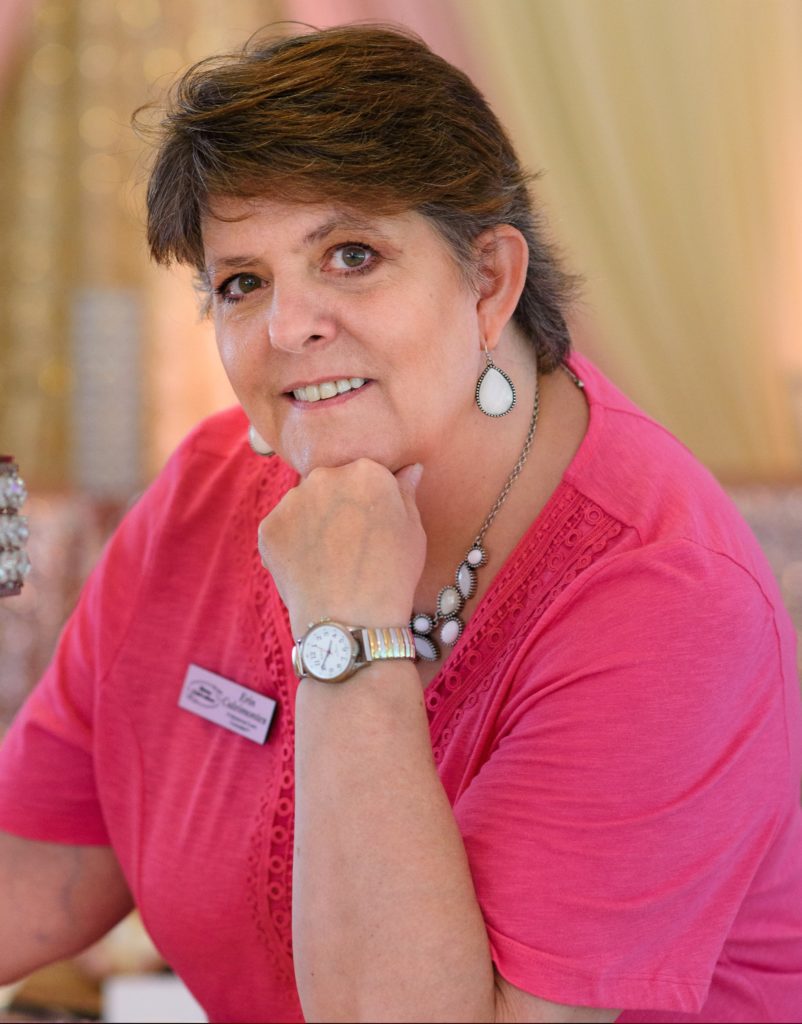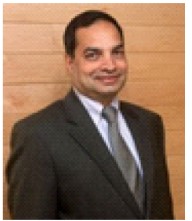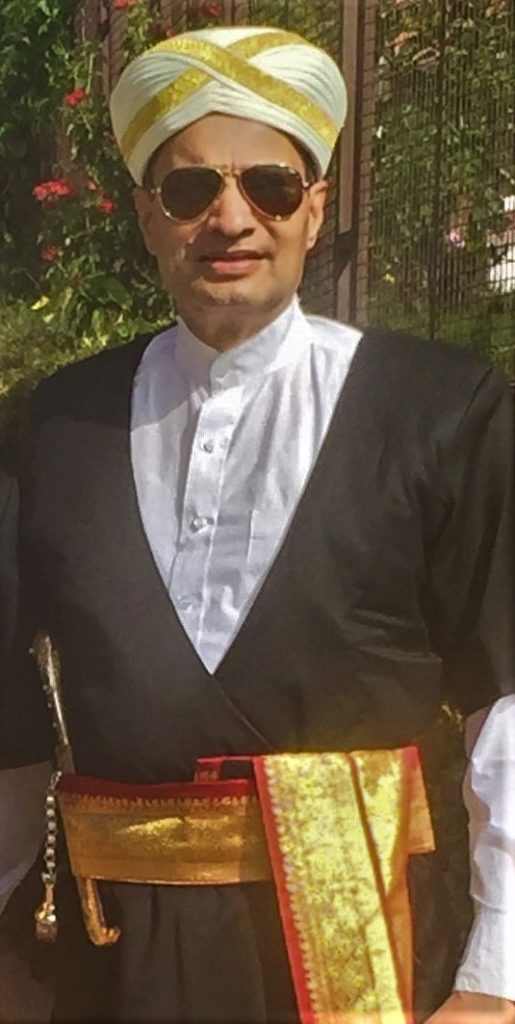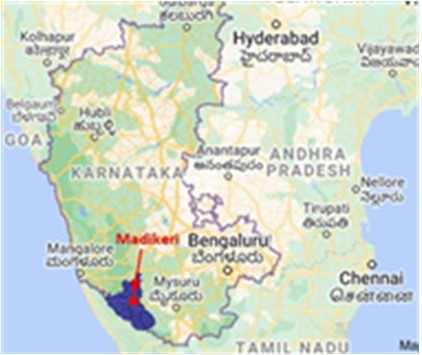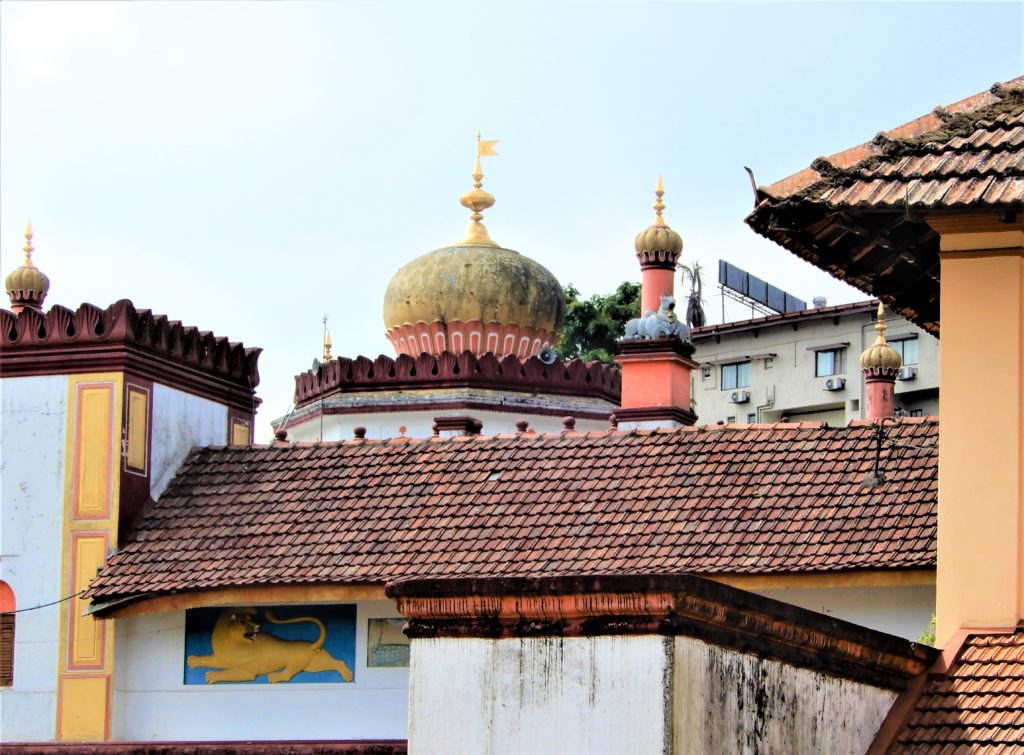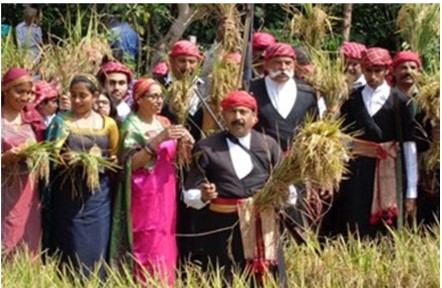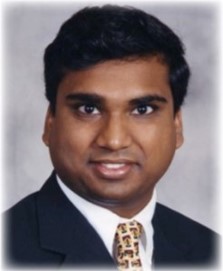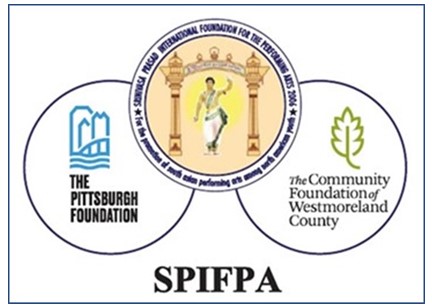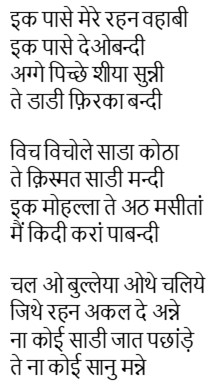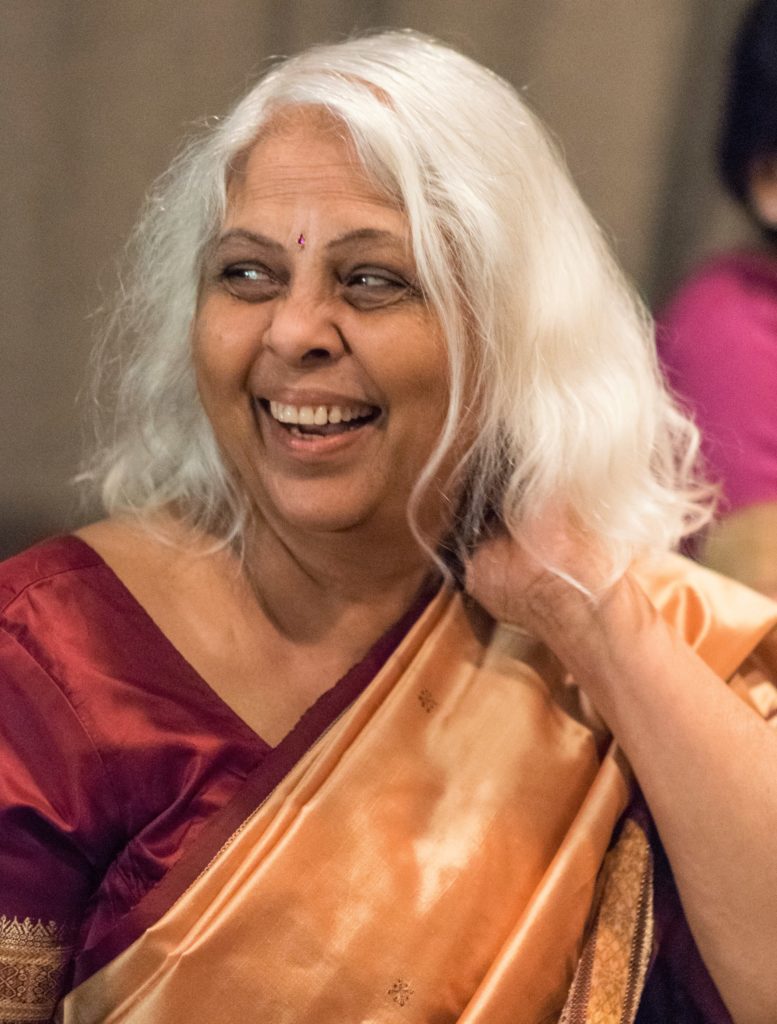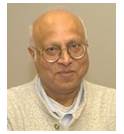Archive for category April 2021
Ha! Ha! Ha!
Posted by admin in April 2021, Past issues on March 26, 2021
Every society has its idiosyncrasies that fascinate outsiders. But when these come in quick succession, it is amusing. That was my reaction on the four news items coming in quick succession in Pakistan’s daily Dawn:
◠Dawn, February 16, 2021: The Islamabad High Court orders razing of “illegally constructed†lawyers chambers in Islamabad.
The Court in a unanimous verdict ruled that the offices built for lawyers on a sports ground in Islamabad were “illegally constructed†and therefore should be razed by the relevant authorities. The verdict was announced by a four-judge bench headed by the chief justice himself.
The verdict said lawyers who allowed the building of the chambers “forcefully [took] the law in their hands…†and added, “The facts of this case are disturbing because the conduct of a few lawyers has caused reputational damage to the entire legal fraternity.â€
â— Dawn, February 18, 2021: “Three injured after fight breaks out between two groups of doctors in a hospital.”
This happened in the city of Gujrat in the Sindh Province in Pakistan. Three people were injured after a fight broke out between two groups of doctors at the Aziz Bhatti Shaheed Hospital. A police official said four people were arrested and two weapons seized from them.
A former president of the Pakistan Medical Association told the media, “We were attacked by [one] Dr Usama Talat and his companions, [who] tortured our doctors.†Making matters worse, he alleged that the police official at the scene, “instead of sorting [out] the matter, inflamed it further†by facilitating the escape of the other group from the scene.
â— Dawn, February 19, 2021: “Politician in custody claims a cobra was deliberately left in his jail cell to kill him.â€
The Leader of the Opposition in the Sindh Assembly Haleem Adil Sheikh claimed that a 4’-long black cobra was in the lock-up room, deliberately left in his cell to kill him on the directives of Pakistan People’s Party chairperson Bilawal Bhutto-Zardari and Sindh Chief Minister Syed Murad Ali Shah. Mr. Sheikh was in custody for violence, firing guns, attempted murder and causing terror during by-elections in Karachi.
One commentator wondered whether the snake was also afraid of Mr. Sheikh in the prison cell.
The grand finale in this thread was this: Dawn, March 9, 2021: “Five courts [were] illegally built on private land, Supreme Court [was] toldâ€
Pakistan’s Supreme Court was informed that as many as five courts have been built illegally in Islamabad on private land. This was disclosed in response to the apex court’s directives in a case related to privately owned lands for a soccer field.
— By K S Venkataraman END
Thank You, Contributors ! An Update on Contributions (as of Match 22, 2021)
Posted by admin in April 2021, Past issues on March 26, 2021
Editor: The Patrika profoundly thanks contributors for responding to our appeal for monetary contributions for continuing with the magazine. As we explained in the October 2020 issue in two articles here and here, our advertisers simply vanished last year at the peak of the Covid-19 Pandemic. As you all know, with no subscription, we depend EXCLUSIVLEY on advertisements, for meeting the expenses for creating, printing and mailing the magazine for 1800-plus homes.
After suspending our magazine for two issues, we again started in October last year.
Given below are the up-dated alphabetical listings by last names of contributors for the Pittsburgh Patrika to tide over the Covid Crisis. The details of contributors prior to December 10 2020 are available here. Again, as before, at the request of donors who wanted to remain anonymous, we truncated their names with ellipsis (… …)
The lists below detail those who contributed between December 10, 2020 and March22, 2021.
Contributions By Checks Reported in This Issue:
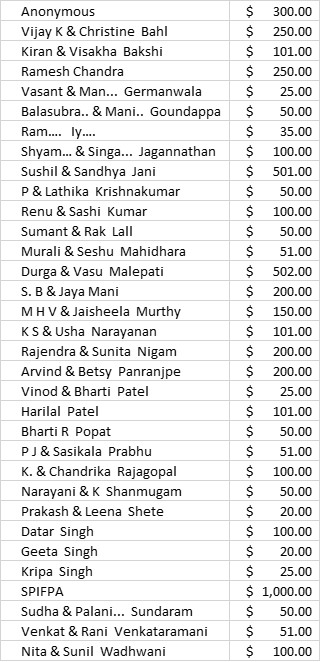
Subtotal of By-Check Contributions: $4959.00
Online Contributions Reported in This Issue:
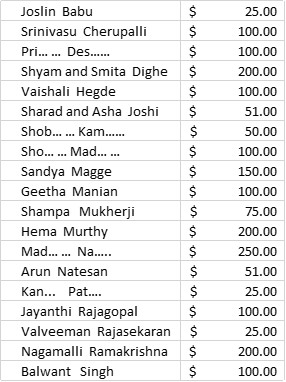
Subtotal of On-Line Contributions: $2002.00
___________________________________________________________________
Please go to www.tinyurl.com/SubscribePatrika and make their contributions on-line for us to meet our target goal.
Home:
Contributions as of Dec 10, 2020:………………………. $11,983.00
Contributions reporting in this issue By Check:………….$4,959.00
Contributions reporting in this issue On-Line: …………..$2,002.00
ALL Contributions as of March 22, 2021: ……. $18,945.00
Target for the fundraiser: …………………….. $20,000.00
Thank all of you once again for your generosity!
END
Matrimonial Bliss & Love NOT Canceled
Posted by admin in April 2021, Past issues on March 26, 2021
By Erin Calvimontes, Divine Celebrations
Editor: Erin Calvimontes, owner and certified/accredited lead planner at Divine Celebrations, specializes in South Asian/Ethnic wedding planning, coordinating, and consulting. www.DivineCelebrations-Events.com. Contact details: e-mail: erin@DivineCelebrations-events.com or Phone: 412-436-0337
Weddings were happening in 2020 and in early 2021 through the Covid pandemic, and are still happening even now. However, they look different — with smaller and more intimate groups. Rest assured, Matrimonial Love won’t be canceled!
I am happy to announce that as of April 4th, 2021, the State of Pennsylvania has lifted the restrictions, and increased the event capacity! Indoor events are permitted at 25% of max occupancy and outdoor events are permitted at 50% of max occupancy. This applies to events even in your own backyard.
Included in the head counts for occupancy are, obviously, the members of your immediate family and guests. But you must also count all venue staff such as banquet captain, waiters & servers, bartenders, catering staff, and all vendors present — including priests, photographers, videographers, DJs, and planner team.
For the protection of everyone in the gathering, invitees and guests need to understand and observe these practices:
◠Guests must be seated if they have a drink. No standing close to each other or mingling without masks. Guests are expected to wear masks when not seated — like when standing at the bar, being on the dance floor, and standing at the buffet line.
◠Food service has changed as well. All servers must wear masks and gloves. Passed hors d’oeuvres must be handed to the guests by the server or set out on individual plates for guests to take.
◠Buffets must have servers serving, cafeteria style, so as to avoid guests handling the utensils, ladles, spatula… …
â— Guests are expected to physically distance from others while in line.
DJs too have adapted for their and everyone’s safety: They stand behind Plexiglas surroundings for their areas and ask guests to TEXT them music requests!
There is light at the end of the tunnel, and we all need to do our part to keep each other safe and healthy, even as we enjoy these auspicious occasions. Please contact your hosts, Divine Celebrations, or your wedding planner to help you get through all the new restrictions. END
Kodagu — Paradise in the Indian Western Ghats
Posted by admin in April 2021, Past issues on March 26, 2021
By Bidanda Bopaya, Fox Chapel, PA
As the son of an Indian naval officer, Bidanda Bopaya was born in Pune, has lived all over the Indian coastline, and was sent to a boarding school in Ooty at a young age. His wife, Louella, daughter of an Indian air force officer, is a psychologist in private practice. The Bidandas moved to Pittsburgh in 1987 after graduate work at Penn State and have raised two children in the Burgh. Their daughter, Maya is pursuing a PhD in finance & economics after an early career on Wall Street, and their son Rahul is an engineering graduate from Pitt. The Bidandas live in Fox Chapel. Bopaya, a professor of engineering at the University of Pittsburgh and President of the Institute of Industrial & Systems Engineers, has authored/edited 13 books in the subjects of his specialization. Here is Bopaya in his contemporary dress and also in the traditional Kodava attire.
Editor’s note: My early childhood was in Madikeri (earlier name Mercara) in Kodagu District, earlier known as Coorg (population: over 500,000 people) in Karnataka State. Madikeri is the headquarters for Kodagu and the home of the Kodavas, a small, accomplished, and colorful community in the Indian social tapestry. Kodavas are ~20% of the population of Kodagu District, and have contributed disproportionately to India’s armed forces, sports teams, and other professions including as India’s first female ambassador, India’s first PhD in sports medicine, the founder of the National Institute of Sports in Patiala, and of course, India’s first Commander-In-Chief (Gen. Kodendera Subbayya Thimmayya), and India’s first Field Marshal Kodendera Madappa Cariappa
After sixty years, I chanced to drive through Madikeri. I had a vague memory of Omkareshwara Devasthana, a Shiva Temple there. Since it was the only temple I knew in my childhood, it made no impact then. When the driver showed me the temple from a mile away from the hills, I told him it looks like a mosque. His reply: “Illa saar, iduve devasthana.†(No sir, this IS the temple.) Stunned at the unique architecture for a Hindu temple with a typical Islamic dome including the four minarets, I stood in silence in front of the temple absorbing the ambience.
Then during the Patrika fundraising, I saw one Bidanda Bopaya as one of the on-line contributors. From the name, I recognized he is a Kodava (known earlier as Coorgis). I contacted him with my Madikeri roots, and one thing led to another in our exchanges, which finally culminated with Mr. Bopaya writing this article for the Patrika. — Kollengode S Venkataraman
The Omkareshwara Temple is a picturesque and unique place of worship in Madikeri, the heart of a salubrious and verdant hill station in Karnataka. Our family spent summers in Kodagu, and the place remained a well-kept secret because of the absence of a railhead. Now, it is a weekend getaway to Bangalore IT techies arriving in hordes.
Steep hills studded with vibrant homes surround the temple. Legend has it that the Raja of Kodagu, Lingarajendra II, built the temple repenting for some terrible act he committed. He was advised to build a Shiva temple that would awe people, “as long as the sun and the moon are around!†He commissioned the temple, consecrating it in 1820, with a Shivalinga brought from Kashi enshrined at the temple’s sanctum.
Omkareshwara Devasthana is the only known example of a Shiva temple — for that matter, any Hindu temple — built like a mosque with four turrets (or minarets) at each corner and a dome at the center. The rationale for this one-of-a-kind architectural style (Islamic with a Gothic touch) for a Hindu temple is not precisely known even though the temple is only 200 years old, given the frosty relations between the Kodavas and Muslims, thanks to Tipu Sultan (1750-1799), who repeatedly invaded and unsuccessfully tried to take control of the region. Search the web under Tipu Sultan and Kodavas to get multiple perspectives of this complicated relationship.
Given today’s strife-ridden global situation among all religions, it is inspiring that one Hindu temple integrated multiple styles of architecture into its place of worship two centuries ago. As children, we played hide-and-seek with our extended family around the temple.
The Raja’s tomb located nearby, built in 1809, also has an Islamic architecture. My great-great-grandfather Bidanda Bopu was the Commander-in-Chief of the Kodagu Raja’s army and is buried next to the Raja. Growing up, our family often celebrated festivals and visited the tomb to pay respects to our ancestors.
The Kodavas are proud people and maintain unusual traditions. Kodagu is often called the land of generals, beautiful belles, coffee, cardamom, pepper and honey, all because of its hilly terrain and suitable weather, honey, large number of military leaders, and charming and gracious women! Some interesting features of Kodavas
â— Are Kodavas Hindus? While Kodavas are governed by the Hindu laws, they are technically not Hindus, with the absence of a caste system; Kodavas are ancestor- and nature-worshippers. Most festivals are centered around agrarian and martial themes and traditions. However, many Kodavas have now adopted a Hindu lifestyle and traditions.
KODAVA FESTIVALS: Kodavas are rooted to their land as farmers and agriculturists. No wonder, all Kodava festivals are around farming.
â— Kailpodhu: After the paddy fields are transplanted in early September, Kodavas worship their weapons and tools, after cleaning and decorating them. This is followed by festivities (shooting competitions, athletic prowess, while feasting on spicy food and copious alcoholic beverages). Kodavas have the right to bear firearms and weapons without license.
◠Kaveri Sankramana: The river Kaveri originates in Kodagu District in a small natural spring in Bhagamandala, close to Madikeri. In mid-October, at a specified time, the sacred River Kaveri — yes, for Kodavas in particular, and for all Kannadigas, Kaveri is sacred — renews with new divine springs gushing towards a larger body of water. This is the birthplace of the river. People take dips in this holy water. Goddess Kaveri is then worshipped in Kodava homes with youngsters touching the feet of elders for blessings. Kaveri is perhaps the most common name for girls among Kodavas. This is the only meatless festival among Kodavas!

◠Puttari (meaning New Rice), is the traditional harvest festival, celebrated in early December when people gather in their traditional family home (ainé mané) nicely decorated with farm motifs. Like Onam, Pongal, Lohri, Baishakhi, Bihu, and of course, Thanksgiving here, special culinary items are prepared. An important part of this festival is the matriarch of the family leading others into the fields for a symbolic first harvesting of rice paddies.
In addition to these, individual villages have temples that celebrate colorful festivals, including walks thru hot beds of coals. The best way to experience these is to be with Kodavas in their home during the season.
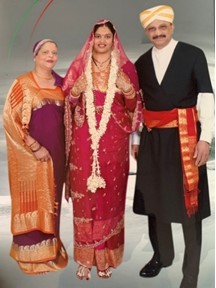
Pittsburgh residents, in traditional Kodava
dress and jewelry at the wedding of their daughter Kaveri.
◠Is there a Kodava cuisine? Yes, of course. Kodava cuisine is replete with unique and fiery dishes including Pandhi Kari (pork curry cooked in a special vinegar), Baimblé Kari (bamboo shoot curry), mangé paji (mango chutney), kuru kari (kidney beans, green beans, in a coconut gravy), akki rotti (rice chapattis) …… the list goes on!!
◠Kodava music, dance and dress are unique and are on display at weddings and festivals. Kodava women elegantly drape themselves in a unique style in standard 6-yard saris. Men wear black wraparounds (kupya), colorful sashes (chalé), and daggers (peeché kathi).
â— Interesting fact: No priests at Kodava weddings. Family elders lead all the religious rites, with a frenzy of Kodava dancing, pandhi curry, libations, and ceremonies steeped in family traditions.
Websites offer a ton of information on tourism-related questions on Kodagu — places of interest, cuisines, lodging, what to do, how to reach, the best time to visit. One website is: www.coorgtourisminfo.com. END
SPIFPA — From the Pains of Grief to an Arts Foundation
Posted by admin in April 2021, Past issues on March 26, 2021
Editor: Drs. Varaprasada Rao and Parvathi Gutti, well-known here for over 40 years, have been patrons of the Indian performing arts in many capacities. This write up is based on information available from the Guttis and other published sources.
The Srinivasa Prasad International Foundation for Performing Arts (SPIFPA), founded in 2005 as a 501(C)(3) nonprofit organization, is familiar to most art lovers in our area. SPIFPA was established in memory of the Guttis’ beloved son ‘Vasu’ (Srinivasa Prasad Gutti) to fulfill his dream. Vasu loved Indian performing arts and had a passion and vision to propagate them among North American youth.
Starting from childhood, Vasu learned Kuchipudi and Karnatic music from legends: late Guru Padmabhushan Vempati Chinna Satyam, Kalarathna A.B. Bala Kondala Rao and Dr. Kamala Rajupet, late Padmasri Pemmaraju Surya Rao, Mandapaka Sarada, late Nedunoori Krishnamurthy and late Nookala Chinasatyam. He earned several awards for his talents both here and in India.
Vasu excelled in his studies. He received the Westinghouse Family Scholarship and the Chairman’s Award in Biomedical Engineering at Case Western Reserve University (CWRU). He was to begin his medical program in 2004 at CWRU with a full scholarship. He was kind and gentle, always ready to help others. Unfortunately, on Memorial Day, May 31, 2004, Vasu died in a ghastly, freak auto accident while he was returning after his recital at the Chicago Tyagaraja Festival.
Since 2005, SPIFPA has been organizing cultural festivals featuring Indian classical music and dance every other year in Vasu’s memory. Further, providing permanent footings to its efforts, it established endowments in India and USA at 1) Sidhendra Kalakshetram, Kuchipudi AP; 2) Potti Sriramulu Telugu University, Hyderabad; 3) The Music Academy, Chennai; 4) Sangeeta Sanmandali, Vijayawada, AP, and 5) Case Western Reserve University Cleveland, Ohio. It also sponsors annually, the Spirit of Youth Festival in Vasu’s memory at the Chennai Music Academy.
In Pittsburgh, SPIFPA as the lead sponsor of Dhirana, the annual national intercollegiate competition in Indian classical dance organized by the University of Pittsburgh’s Indian classical dance team Nrityamala. judges and presents awards (a citation and $500 gift) to the top two teams.
Recently the SPIFPA board approved initiation of the “SPIFPA Advanced Student Fellowship award†for a student producing a “White Paper†on a South Asian performing art of their choice. The two-year project with a significant stipend will document the origins of the art form, the patrons and gurus that contributed to its evolution in India, and the challenges it faced in transplanting the art form in North America.
At the Valley School of Ligonier in Pennsylvania, Vasu was the valedictorian in his graduating year. Recognizing Vasu’s achievements and his passion to promote the arts, the board of directors at the school in 2020 approved to naming stage of the auditorium as the “Vasu Gutti Performing Arts Stage†with his portrait displayed. Every year, the school will host a visiting South Asian artist to perform at the school. This is a significant recognition for the Indian community here. A $1000 honorarium from SPIFPA is under consideration for the artist.
Over the years has SPIFPA partnered with the Community Foundation of Westmoreland County (CFWC) and the Pittsburgh Foundation to promote South Asian performing arts.
In the cultural festivals SPIFPA organizes, accomplished teachers and artists are recognized, and promising students are encouraged to preserve and propagate the arts forms. Here are the artistes SPIFPA has honored and recognized since 2010:
◠Lifetime Achievement Award: Rathna Papa and Revathi Satyu, both from Houston, TX) — Commemorative Plaque & $1000 honorarium.
◠Ambassador Performing Artist Award: Jaya Mani (Pittsburgh PA), Sithalakshmi Madhavan (Pittsburgh PA), Sasikala Penumathi (Atlanta GA), Kamala Reddy Rajupet (Pittsburgh PA), Anuradha Nehru (Washington DC), Mythili Prakash (Los Angeles, CA), and Manu Narayan (Hollywood CA) — Commemorative Plaque and $1000 honorariums).
◠Youth Artist: Madhav Iyengar (Pittsburgh PA), Pallavi Mulukutla (Pittsburgh PA), Sarang Mulukutla (Pittsburgh PA), and Sundararajan Venkataraghava (Philadelphia PA) — Commemorative Plaque and a $500 gift.
◠Child Artist: Sia Iyer (Pittsburgh PA) — Commemorative Plaque and $500 gift).
SPIFPA will continue to conduct cultural festivals and special events to inspire accomplished artists and youth. SPIFPA appreciates the support and participation of all art lovers in its efforts to promote South Asian performing arts among North American youth. For additional details, please contact 724-309-7340 or spifpaorg@gmail.com. END
Indian Thoughts against Religious Exclusivity through the Centuries
Posted by admin in April 2021, Past issues on March 26, 2021
By Kollengode S Venkataraman thepatrika@aol.com
The details of the life of Bulleh Shah (or Syed Abdullah Shah Qadri), the 18th century Sufi poet of the Punjab region in the Indian subcontinent are not precisely known. Scholars believe, he was born in Bahawalpur in 1680 and died in Kasur in 1757, places in the Pakistani Punjab today.
In Bulla’s time, the Punjab region was in social, cultural, and political turmoil, with Aurangazeb (1658-1707) in Delhi and with armed raids from the west by Nadir Shah and Ahmad Shah Abdali (1747–1773). The Sikhs, suffering the most from the brutality of the Mughals and from violent incursions from their western borders, were asserting themselves. Even within Islam, there was strife for control among the different factions.
Growing up and living in this era, Bulleh Shah, as we see in his poems in his mother tongue Punjabi, was disillusioned with the religious bloodletting even within Islam.
I heard one of his verses two years sometime back on YouTube (www.youtube.com/watch?v=gY41LNcSTiM). My Punjabi is zero, yet I could catch the first two lines. Having read earlier Bulleh Shah’s ideas on the Godhead, I could guess where he was leading to.
So, I asked Juginder Luthra, familiar to the Patrika readers, to get the verse in the Devanagari script and also to translate the verse into English.Mr. Suhendra Singh Ajmani, through Shri Sucha Singh, the Granthi Sahib at the Monroeville Gurudwara, got the Punjabi poem in the Gurumukhi script. Here is Bulleh Shah’s poem in translation dripping in disillusionment, sarcasm, ridicule, and anger, all rolled into one:
On my one side live Wahabis,
On the other, Deobandis;
In front Shias and behind, Sunnis,
All live in strict schism restrictions
In the midst of this is our house.
What bad luck!
One village — eight mosques!
Which one should I follow?
Get up Bulleya! Move to a place,
Where live those with blind mind,
Where no one recognizes my caste,
Where none has to agree with me!
Here is the original in the Gurumukhi and the Devanagari scripts:
..
Kabir Das (15th century) similarly shows his disgust on the polemics between Hindus and Muslims of his time.
Rebelling against religious exclusivity has a long history in the Indian subcontinent, as we can see in the Bhakti literature all over the subcontinent. Here is a nuanced example in Tamil, from Kamba Ramayanam (10th or 12th century work), by the great Tamil poet Kambar:
Background: Hanuman is on his way to Sri Lanka to know the whereabouts of Sita. On his way, he has to cross over the Arundhati Hill Range with its peaks protruding into the skies like the palisades. Hanuman’s advisor, knowing that the mountain is dangerous to cross over, advises him to go around the hills. To describe the difficulty of crossing over the mountains, Kambar uses an unusual imagery:
Translation: This hill range is as difficult to fly over “as it is difficult for those ignoramus people to get moksha (liberation from bondage), who bicker on who is superior — Shiva or Vishnu.â€
What made Kambar to use such an unusual imagery? I can only surmise: in Kambar’s time (several centuries before Bulleh Shah), the followers of Shiva and Vishnu in the Tamil country were bickering between themselves in diatribes that must have disgusted Kambar. So, Kambar weaves a contextual imagery to subtly let people know how he feels on the futility of such tirades.
So, the expressions and imageries portrayed in these rebellious poems are always contextual for the place, time, and situation. Here is another example by the 14th century(?) Sivavakkiyar, which holds true for all times, all faiths, all places and all situations:
Your God and our God — Really two are there?
Is not the Primordial One here, there, and everywhere?
When the Primordial One is here, there, and everywhere,
Let them rot and perish, those who differentiate!
This type of theological squabbling is the bane among believers both of different faiths, but also within any one faith all over the world, including Christendom. The long history of the splintering in Christendom is gory since it was also tied to temporal and political power. In early centuries, Catholics (from Rome) and the Eastern Traditions (Greek, Russian, Serbian, and Syrian orthodox churches) were the main groups. But in the 16th century, the Church of England and the Lutherans in Germany broke away from Rome for different reasons. These Protestants later splintered into a large number of subgroups — Anglicans, Evangelicals, Mennonites, Charismatics, Fundamentalists, Baptists, Seventh Day Adventists, Methodists, Pentecostals… with constant bickering.
Consider this: Monroeville (population 28,000) in the eastern suburb of Pittsburgh, has 24 churches belonging to different Christian denominations and three Hindu temples. Imagine what Bulleh Shah would say if he were to visit Monroeville today!
But nowhere in the world, it seems to me, did the free spirits on spiritual matters have as much freedom to express themselves uninhibitedly as they had, and still have, in India. I say this because these types of unorthodox poems are recited and elaborated even today in Gurudwaras, Hindu temples, in kirtans, and in discourses all over India.
This is something the Occidental minds — both native Europeans and the Europeanized Indians — often fail to grasp. This is because, many of them, particularly the Europeanized Indians, have no grounding or familiarity with India’s many languages and its long spiritual journey and its many literary traditions. END
Home
Obituary: Bhanumathi Pandalai (1945 — December 22, 2020): Friendly, Gracious, Elegant, Enterprising
Posted by admin in April 2021, Past issues on March 26, 2021
By Premlata Venkataraman thepatrika@aol.com
Bhanumathi Pandalai, a long-time resident in our area, well-known to many, and my good friend and inspiration for over three decades, died on December 22, 2020 from complications of breast cancer. She was 77.
Bhanu was born on February 10, 1945, in Thenkara, in Palakkad District, Kerala to Sri P.K.C.Raja and Smt. Sreedevi Kovilamma. She attended Zamorin’s Guruvayurappan College in Kozhikode, founded by her extended family in 1877. Her undergraduate degree, earned when she was 19, was in mathematics, with minors in physics and chemistry. She married Krishnan Pandalai in 1965 and arrived in the US in 1966. They moved to Pittsburgh in 1973 after living in Ohio and New Jersey.
Her love of Karnatic music made her a connoisseur of the arts. She and her husband hosted musicians and dancers — both celebrated and little known — in their home for weeks during their concert tours. She was well versed in Sanskrit and Malayalam poetry and prosody. We reveled in her reciting from memory Sanskrit and Malayalam poems in complex meters. In concert halls, she chuckled when Karnatic vocalists mangled lyrics.
While many grapple with issues of identity when migrating to foreign lands, Bhanu seamlessly combined elements of contemporary and traditional values into her life, and subliminally influenced others too who interacted with her. She was nuanced on matters of faith and spirituality, probably on account of her eclectic upbringing in a culturally rich home atmosphere. An eternal optimist, she would seek workable solutions to challenges. Even from her sick bed she talked about forming a group of women to visit bed-ridden elders for conversations and bringing some home cooked food.
When her husband started a business in the 1990s in specialty industrial coatings, she was fully with him. To help herself in the business, she obtained an associate degree in accounting. She would tell her son Gopi, “The subject I did not like in college — chemistry — ended up dominating my life.†She was the coatings formulator, analytical chemist, and quality control manager for customers. She herself ran analytical instruments for production and quality control, something she learned on her own.
After her husband Krishnan’s death in 2001, she took care of the manufacturing with her son focusing on marketing. Their business saw a three-fold growth, no mean achievement for Bhanu. When she was diagnosed with breast cancer in 2008, she took a leave, but resumed work after a year. In 2018, she fully retired, with the return of the breast cancer.
Shobha Madhav, who knew Bhanu for well over 40 years, recalls: “Whenever I faced a stressful situation — and there were quite a few in my life — I would think how Bhanu handled her challenges with fortitude and optimism. We talked about this among ourselves. I am glad I told Bhanu she was my inspiration. Decades ago, in pre-cellphone days, she picked me up from the airport at 1:00 am in snowy winter when my husband missed his flight to meet me at the airport.â€
Jayashree Ranka of Monroeville, younger to Bhanu by decades, helped her during the cancer treatment. She fondly says, “Bhanu’s smile and glitter in her eyes were infectious. She never complained about what she was going through. She had a great sense of humor. We enjoyed many cups of tea over the years. She was an open minded Aunty, never judgmental.â€
Rajshri Gopal, a long-time friend, now living in Falls Church, has shared many of her challenges in life with Bhanu. She remembers, “Bhanu was multifaceted, a well-polished high priced gem! She was a connoisseur and charming hostess to musicians, and a fun-filled friendly mentor to youngsters. She was a tireless, unassuming volunteer at the temple. To people like me she was an irreplaceable confidante — a rare treasure.â€
Bhanu’s daughter Dr. Sudha Pandalai, a physician, was a great source of strength for Bhanu towards the end of her struggle. Sudha is with the federal government’s CDC as a specialist in occupational medicine.
Bhanu’s mortal remains were cremated at the Jobe Funeral Home in Turtle Creek on December 23, with Purohit Shri Venkatachari helping with the religious rites. Many will miss Bhanu’s enthusiasm and her bright smile that guaranteed that we would find one friendly face in any event around our Indian community.Â
Say “Cheese†While Taking the Jab!
Posted by admin in April 2021, Past issues on March 26, 2021
Arun D. Jatkar, Monroeville, PA ajmarathi@gmail.com
I fully understand and highly appreciate it when people in high positions such as President Joe Biden and Prime Minister Narendra Modi are photographed receiving vaccine injections for Covid-19, and those photos are widely and repeatedly publicized on TV. They have a significant value: they send a much-needed message to people who are sitting on the fence or totally resistant to the idea of getting vaccinated against Covid-19. The photo of the first Black nurse in New York City getting the vaccine jab is important for the same reason.
But now I am receiving messages via WhatsApp from my high school buddies in Pune, India, showing them receiving the vaccination shot. In some photos the nurse who gave the injection is also posing for the photograph.
I wonder if these photos have a value. Sometimes I think, they do. They tell their friends to stop procrastinating and register to get the shots. But it has spawned some funny exchanges that show facets of mind, for which the folks from my hometown are famous:
â— People have started asking whether the vaccination center provides a photographer, or whether you have to make your own arrangements for the photoshoot.
â— This has a special significance because if you go to a municipal hospital, the vaccination is free of charge. If you go to a private hospital, you pay INR 250 per shot per person.
â— If you took the vaccination at a municipal hospital at no cost, those who took it at a private hospital for INR 250 fee would look down upon you.
â— Too many people getting themselves photographically shot while receiving the vaccine is slowing down the process. So, now there is a concerted move at many hospitals to give the second shot on the butt, rather than on the arm.
◠In Marathi, it is common to say, “He does not take it!†to mean that he does not drink (wine, whiskey, etc.). The same verb is used when people enquire of each other whether they took the vaccine injection.
◠A friend has sent a message saying, “Until yesterday people used to respect me because I steadfastly refused to ‘take’ it. Now, I am an object of intense hatred because I have not ‘taken’ it yet.†It is, indeed, a strange world!
The Farce Called the Trump Impeachment Trial
Posted by admin in April 2021, Past issues on March 26, 2021
By Kollengode S Venkataraman
In impeachment trials in the US Senate, the 100 senators are not bound by any legal precedents or any law books. The senators are guided by the political calculus of the day — how their votes will be perceived by their heavy-weight political establishment, donors, and vocal constituents in their states, and whether they face their reelections in the next 2, 4, or 6 years, or if they are retiring. Besides, in impeachment trials, 67 out of 100 Senators need to convict the president. The merits/demerits of the case in terms of probity, ethics, and (in)discretions in the behavior/conduct of the person holding the highest office in the nation are only peripheral.
That is how the US Senate acquitted former president Donald Trump in the last February impeachment trial — it now looks as if it happened fifty years ago — for the January-6 attempted insurrection of the US Capitol by hoodlums, inspired or instigated by Trump’s exhortation in his public address in the Washington Mall area. It surprised no one that 43 Republican Senators voted against the conviction with their tribal instincts of fear of retribution by their political masters, donors, and supporters back home, irrespective of the merits of the case.
This is in sharp contrast to the trials of ordinary mortals in courts, or in military court martials, where the judges are governed by statutes, guidelines, and precedents in giving their judgments. And, unlike any court decisions, the verdict of the US Senate in impeachment trials is final.Â
So, next time around, when elected representatives in the wretched Second and Third World countries in Central and South America and in Asian democracies vote purely on the basis of their tribal/ethnic/caste or religious affinities (Communists vs Reformers in China and Russia, Shias vs Sunnis, Christians vs Muslims, Hindus vs Abrahamics) even in cases with no grey areas between right and wrong, the US should remember not to pontificate using highfalutin hyperbole. After all, when it was their turn, the members of the self-proclaimed greatest debating body in the world, the US Senate, behaved no differently. Critics of the US would only retort by asking the US to look at itself in the mirror.  END
Do You Know the Anti-Microbial Properties of Copper Alloys and Silver?
Posted by admin in April 2021, Past issues on March 18, 2020
By Kollengode S Venkataraman
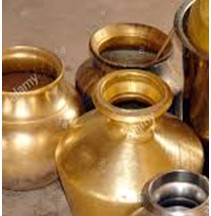
One of the rewards of aimless drifting on the web is the gems of information you unexpectedly get in the pile of worthless sand, known as gangue in the mining industry. It is like the story in the Yoga Vaasishtham: A miser desperately searching for the copper coin he dropped in the pile of rocks, after his long search, accidentally ends up with the chintamani — something like the philosopher’s stone — that would grant him all his wishes. The Chintamani story is another story for another day … Let us stay with copper for now.

Many readers now in their 60s and 70s may remember growing up in simpler times in barely functional homes in Indian cities, towns and villages. Before the now ubiquitous stainless steel and aluminum invaded Indian kitchens, copper, copper alloys (brass and bronzes) and sterling silver were the metals of choice for vessels for storing water, cooking and eating.
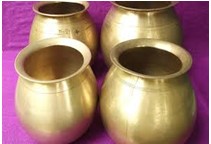
I still remember using brass vessels in our homes and the homes of my friends and relatives for storing water, and brass tumblers for serving water. The more affluent in South India used silver plates and tumblers for dinner ware. See the traditional copper/bronze cookware still available in India shown in pictures used in this story.
An important note: Many items commonly used in Indian cooking like tamarind (imli or puLi), lemons and lime (as juice, or as cut pieces in pickles), even milk, dahi, yogurt and buttermilk, all chemically react with copper and brass surfaces. This is because the acids (tartaric acid in tamarind, citric acid in lime, lemon and even in oranges, and lactic acid in milk and yoghurt and butter milk) used in cooking react with copper and brass surfaces. This releases copper and zinc tartarates, citrates, and lactates into the food prepared and stored and destroy the taste of the of food products. Traditional Indian women knew this very well, and never used copper/brass vessels for cooking that required boiling. But in Indian homes for storing water at room temperatures and serving water and eating food already prepared in meals, brass plates and tumblers were the choice.
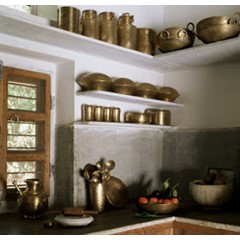
Today, copper, brass, silver and bronze utensils, plates and tumblers are gone in kitchens in middle class and above-middle-class homes all across India in the name of modernity. They were first replaced by stainless steel and aluminum. In recent decades, thermosetting plastics, glassware, and porcelain have entered the cookware market in big ways.
Among the working poor, however, copper and bronze are still used for storing water, cooking and eating. One hopes this stays this way. But plastics and aluminum are making inroads.
This is a great tragedy because copper and copper alloys have antibacterial, antifungal and antiviral — generically known as antimicrobial — properties even at room temperatures. This is something I came to know accidentally in my internet forays. This property of copper and copper alloys can be used cost-effectively for preventing to the extent possible water-borne diseases among the working poor. Poor water quality and sanitation facilities are the bane for the working poor in India. To mitigate this issue, all we need to do is to selectively reinvent copper and brass alloys in kitchenware through proper public health programs.
Here are fascinating reports that the simple copper and copper-rich alloys and the expensive silver have effective antimicrobial properties:
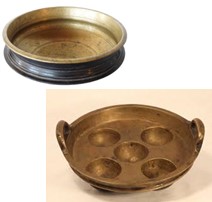
In controlled experiments in labs, when gram-positive and gram-negative bacteria came into contact with metallic copper as foils and plates in water at room temperatures, within in two hours, the water was purified of the disease-causing pathogens, with over 99% of the disease-causing pathogens getting killed. Here is the reference to the first technical paper: Antimicrobial Properties of Selected Copper Alloys on Staphylococcus aureus and Escherichia coli … … by a group of Polish healthcare professionals and metallurgists Anna Rozanska and coworkers. Reference: www.ncbi.nlm.nih.gov/pubmed/28726753.
Here is the authors’ conclusion in their study: “This study confirmed the antimicrobial properties of copper alloys, and additionally showed that Staphylococcus aureus (SA) was more resistant than Escherichia coli in the variant of the experiment without organic contamination. However, even for SA, a total reduction of the bacterial inoculum’s density took no longer than 2 h.†But stainless steel, the ubiquitous metal used today in India for cooking and eating did not have this beneficial property.
Modern medicine has been using silver ions in skin care and for healing wounds. In the prestigious journal Nature (June 19, 2013) is this article by Brian Owens on silver’s efficacy for fighting bacteria: Silver makes antibiotics thousands of times more effective: Ancient antimicrobial treatment could help to solve modern bacterial resistance. The title tells it all. Here is the reference for the article in Nature: www.nature.com/news/silver-makes-antibiotics-thousands-of-times-more-effective-1.13232.
A ton of information is available on the web on the antimicrobial properties on copper and silver. You can start in Wikipedia.
Water-borne diseases are a big problem in Africa and Asia and the Americas as well. People are advised to boil the water — at great expense given the high cost of fossil fuels, or fossil-fuel-generated electricity. So, maybe we need to reintroduce — and rediscover — copper and brass as complementing metals of choice Indian kitchens for storing and serving water in homes. This will help in cost-effectively managing water-borne diseases among the Indian poor, a chronic public health problem having great social and economic costs. End$$$$

